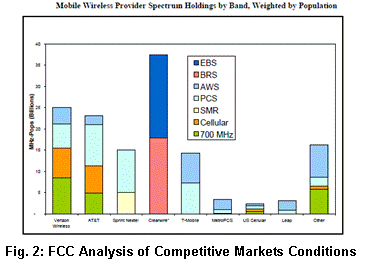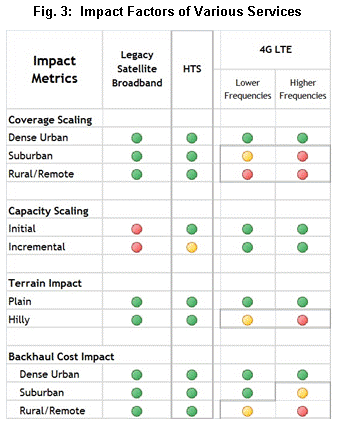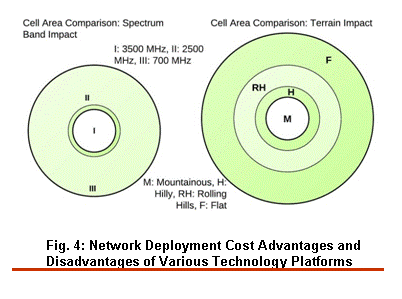HTS-Powered Consumer Broadband Services: Are They Late to the Party?
by Rajiv Hazaray
Bordertown, NJ, May 2, 2012--During Satellite 2012, the Society of Satellite Professionals International (SSPI) bestowed the Industry Innovators Awards on Eutelsat Communications and ViaSat Inc in recognition of the development and launch of their High Throughput Satellites (HTS), KA-SAT and ViaSat-1, respectively. High frequency reuse and multiple spot beam architecture have packed 10 times capacity on these Ka-Band satellites without any deployment cost penalties.
Eutelsat's 70 Gbps KA-SAT satellite with 82 spotbeams was put in service in May 2011. KA-SAT powers the Tooway™ broadband service to provide speeds of up to 10 Mbps down/ 4 Mbps up. It has ambitious plans to serve various European countries as well as the Mediterranean Basin. October 19th, 2011, ViaSat launched ViasSat-1, with coverage over North America and Hawaii. It made ripples with the announcement of its 12 Mbps ‘Excede’ service for $50/month. Hughes, is not quite far from the launch of its 100 Gbps Ka-band high-throughput satellite to be called “Jupiter.”. HTS platform won another confidence vote recently. NBN Co., the Australian state-owned broadband provider, selected Space Systems/Loral (SS/L) to build two next-generation Ka-band satellites, scheduled to be launched in 2015.
The launch of HTS-powered consumer broadband service, for the very first time, has placed satellite broadband in parity with (and in a few cases, in superiority to) the terrestrial technologies in terms of cost per bit of throughput and let it augment its box of goodies beyond the sole virtue of ubiquity.
But is it too little, too late?
ViaSat pointed out during the presentation of their 2011 3rdQuarter results (see Figure 1) that HTS has moved satellite broadband up the food-chain from being a dial-up substitution to be a DSL-substitution. But, in this ever-dynamic wonderland of broadband marketplace, is this triumph a bit too little, too late, in a world where video wants to go mobile and multi-screen? Satellite broadband has definitely jumped out of the frying pan, but has is landed in a fire?
out during the presentation of their 2011 3rdQuarter results (see Figure 1) that HTS has moved satellite broadband up the food-chain from being a dial-up substitution to be a DSL-substitution. But, in this ever-dynamic wonderland of broadband marketplace, is this triumph a bit too little, too late, in a world where video wants to go mobile and multi-screen? Satellite broadband has definitely jumped out of the frying pan, but has is landed in a fire?
Figure-1 depicts HTS to be in the same ecosystem quadrant as Mobile 4G and 3G. AT&T and Verizon have been accumulating prime spectrum “real-estate” to dominate the supply in this quadrant. FCC has pledged to add another 500 MHz of prime spectrum to the wireless arsenal by 2020. Verizon is defending a US$ 3.6 billion deal with Time Warner Cable., Comcast, and Bright House Networks to acquire additional spectrum for rolling out its 4G network. AT&T has announced that it will serve 70 million Americans with its 4G LTE Network by end-2012.
In this context, the multi-billion dollar question is: will HTS-powered consumer satellite broadband withstand the competitive pressure from the new 4G wireless service and thrive?
Fortunately, there is no one answer!
 4G LTE has the capacity to support a robust broadband service. However, the demographic and topographic diversity in the service areas and the limitations inherent in the terrestrial wireless technology will offer HTS-powered consumer satellite broadband enough opening to snatch a few beachheads from its competition on which it can build its future battle plan.
4G LTE has the capacity to support a robust broadband service. However, the demographic and topographic diversity in the service areas and the limitations inherent in the terrestrial wireless technology will offer HTS-powered consumer satellite broadband enough opening to snatch a few beachheads from its competition on which it can build its future battle plan.
The visual map in Figure 4 compares the network deployment cost advantages/disadvantages of various technology platforms. Deployment costs directly impact the economic wellbeing of a network. High network deployment cost may mean a suboptimal service that may increase the churn, which in turn would not let the operator recover the CPE subsidy during average subscriber life.
HTS Sweet and Sore Spots
Let us take a closer look at each of the impact factors mentioned in Figure 3.
Coverage Scaling:
One doesn’t need a proverbial rocket scientist to tell us about the coverage superiority of satellites over terrestrial wireless networks. Though, HTS’s coverage advantage is more pronounced in spread-out service areas, this benefit varies widely. We know that for an identical QoS, the radius of the cell tower is inversely proportionate to the Hz rating of the wireless spectrum used (Figure 4). Thus, wireless networks using higher frequencies require many more cell stations to cover a given service area and would have a greater disadvantage compared to the ubiquitous coverage of HTS. The heavy cost of base station build-out is bound to result in considerable gaps in the 4G Wireless coverage, at least for the next few years helping HTS penetration.
Capacity Scaling:
 In contrast to the coverage superiority, satellite networks have historically not fared well against the terrestrial networks on the capacity front. This disadvantage is considerably alleviated by High Throughput Satellites. Noteworthy is the meteoric drop in capacity cost since the increased capacity comes with no cost penalty. HTS still needs to follow a step function to scale if its present satellite becomes constrained.
In contrast to the coverage superiority, satellite networks have historically not fared well against the terrestrial networks on the capacity front. This disadvantage is considerably alleviated by High Throughput Satellites. Noteworthy is the meteoric drop in capacity cost since the increased capacity comes with no cost penalty. HTS still needs to follow a step function to scale if its present satellite becomes constrained.
In comparison, the capacity of a terrestrial 4G network is largely a function of the amount of spectrum controlled by the competing wireless operator possesses and the extent of frequency reuse achieved through cell build-out. A wireless operator with fewer spectrum can quickly get capacity-constrained and will need to build new cell stations to reuse the available spectrum. Of course, such build-out can get expensive, especially when cell radii are smaller. Thus, low-cost HTS throughput can neutralize some of the capacity-scaling advantages of wireless operators; particularly those using higher frequencies.
Terrain Impact:
Less than half of the US is flat. Terrain has a significant impact on the network deployment cost of any terrestrial network, more so in case of a wireless network. Areas with rougher terrain require smaller cell radii since mountains and hills block wireless signals (refer back to Figure 4). Obviously, HTS may have cost superiority providing coverage in such topography since it is not impacted by terrain issues.
Backhaul Cost:
Backhaul is a crucial cost element for the terrestrial 4G networks, especially while connecting the far-flung service areas. A vast majority of the cell towers in US still depend on the traditional DS-3 connections for the backhaul, which prove very expensive at high throughput levels. On the other hand, Fiber and Microwave backhaul get expensive if the target service area is farther away. This will augment the advantage that HTS has over 4G Wireless in rural areas.
Can HTS Win?
Satellite industry had seen big wins against terrestrial networks in the television arena. Can those spectacular wins be repeated in the broadband battlefield? Will HTS lead the way?
battlefield? Will HTS lead the way?
HTS has undoubtedly achieved a quantum leap in throughput and significantly reduced the cost per bit. It has taken the battle to the competitors’ safe grounds. During next few years, HTS can aim to gain foothold in a few beachheads by capitalizing on its comparative strengths discussed above. The big & prime-spectrum 4G Wireless roll-outs (AT&T and Verizon) would be sequential – beginning with dense urban areas, going out. This would leave out enough service gaps that HTS can leverage and win a good number of battles. However, for a sustainable win in the war with its 4G competition, it will need a quick and significant follow-on progression towards HTS+. Fortunately, industry leaders are already planning the next moves!
--------------------------------------------
 Rajiv Hazaray is the Managing Principal of Business Analytix (www.business-analytix.com), an advisory firm that has served many leading satellite, broadcast, and technology companies as well as investors in strategic analyses covering new ventures & projects, partnerships & acquisitions, public policy issues, techno-economic studies, market profiling, pricing, and valuations. He can be reached at rajiv.h@business-analytix.com.
Rajiv Hazaray is the Managing Principal of Business Analytix (www.business-analytix.com), an advisory firm that has served many leading satellite, broadcast, and technology companies as well as investors in strategic analyses covering new ventures & projects, partnerships & acquisitions, public policy issues, techno-economic studies, market profiling, pricing, and valuations. He can be reached at rajiv.h@business-analytix.com.






